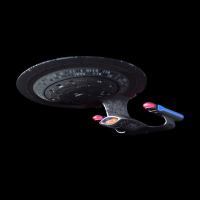We’ve seen it many, many times: the ship gets into a firefight, takes a few hits, shakes around, and consoles explode (possibly taking an unfortunate ensign with them). Eventually the battle is resolved with our heroes largely intact if somewhat shaken up. If it was a particularly nasty battle, there will be signs of damage: scorches on the walls, deformed equipment, busted lights, and rocks scattered about.
All of that seems reasonable… except the rocks, which look pretty out of place in a spiffy 24th century starship. So why are they there?
Ah, you’re talking about the ROCK-E system: Rapid Overload Conversion to Kinetic Energy. It’s a safety feature. When the consoles are damaged, the exposed EPS connections would naturally send out highly energetic plasma arcs, killing anyone nearby. Instead, the safety mechanism automatically converts that energy to harmless matter and ejects it from the console.
My understanding is that the “rocks” are a product of the electroplasma system being exposed to air. Whether that is some sort of coolant that is meant to seal the EPS leak in that console or some sort of EPS byproduct reacting in air, I don’t remember or have a head-canon for it.
All of that said, if I form this reply into one worthy of Daystrom, then I say it is an intended safety mechanism to protect the crew against catastrophic failure of the EPS conduits.
I’ve been making that observation for at least 30 years about how Starfleet components are silicate based.
One of thoughts I’ve had over the years is that what we as see as rocks is actually the afterproduct of an internal fire suppression foam.
There’s a lot of high voltage coursing throughout consoles, what with electroplasma conduits and all, and in a battle situation with shields trying to absorb energy from impacts the danger of overload is very real. When that happens, fire suppression systems spray the inside with a rapidly hardening foam to prevent catastrophic explosions. But when the systems get inevitably overwhelmed and the console blows, the expended and hardened foam shatters, expelled like rocky debris so make room for the next level of suppression to take over. Without the foam, the explosion would have been much worse.
In the 32nd century, my headcanon is that the programmable matter is just bricking into something that looks like rock.
For the 24th century, conductive concrete as a Faraday cage and frame for the bridge modules. (…and yes conductive concrete Faraday cages exist in real life, even if they’re not quite the same shade of gray).
My headcanon is an energy-rich but extremely sensitive and volatile material that augments their power supplies superior to any non-Starfleet tech.
That was what I always thought, or advanced ceramics or something of that ilk … though all the dust would be really bad to breathe in!
removed by mod
This community is for in-depth discussion. While this is a pretty good joke, if it doesn’t further an in-depth discussion of the matter at hand, it’s not appropriate here.
Edit: stupid procedural memory, this isn’t a subreddit at all!
removed by mod
That is how the rules of this community work, yes.
Ah I understand now, this is the taking Star Trek as seriously as if it were real life community. Sorry, I’ll un-subscribe because I love the show but can’t manage that level of suspension of disbelief.
Close, but not exactly. While this community is for in-depth discussion of Star Trek, we don’t expect-- and in fact generally discourage-- answering from an in-universe perspective.
Maybe they are chunks of some kind of ceramic like material.
What, you don’t think they’d replicate a starship to be made out of concrete?
I joke, but I think that’s the idea. Real-world disaster zones will have bits of concrete rubble, and the visual effects people were probably copying that. I do suppose we never see a ship being replicated, so maybe they’re made the old-fashioned way and asteroid-based concrete is actually used for cost (however that’s evaluated in-universe) reasons.
And what’s with the electrical blowouts and explosions? There’s no need to run high voltage or plasma throughout the bridge, these are control systems, it should all be low voltage computers.
Maybe it is and that’s why it blows up when the plasma conduit leaks












